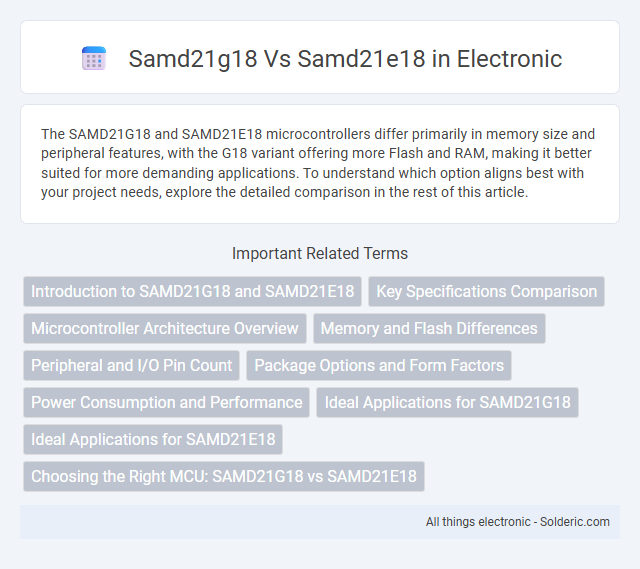The SAMD21G18 and SAMD21E18 microcontrollers differ primarily in memory size and peripheral features, with the G18 variant offering more Flash and RAM, making it better suited for more demanding applications. To understand which option aligns best with your project needs, explore the detailed comparison in the rest of this article.
Comparison Table
| Feature | SAMD21G18 | SAMD21E18 |
|---|---|---|
| Core | ARM Cortex-M0+ | ARM Cortex-M0+ |
| Flash Memory | 256 KB | 32 KB |
| SRAM | 32 KB | 8 KB |
| Operating Frequency | 48 MHz | 48 MHz |
| ADC Channels | 16 channels | 8 channels |
| Package Types | QFN 48, QFN 64, QFN 64 A, QFN 64 B, QFP 64, BGA 64 | QFN 32, QFN 48 |
| Power Consumption | Low power, typical 25 uA/MHz | Ultra-low power optimized |
| Use Case | Higher memory and peripheral needs | Compact, low-power applications |
Introduction to SAMD21G18 and SAMD21E18
SAMD21G18 and SAMD21E18 are microcontrollers from Microchip's SAM D21 series, based on the ARM Cortex-M0+ core, designed for low-power and high-performance applications. The SAMD21G18 offers up to 256KB of flash memory and 32KB of SRAM, while the SAMD21E18 provides 128KB of flash and 16KB of SRAM, making the G18 variant suitable for more memory-intensive tasks. Both feature versatile peripherals such as USB, ADC, DAC, and multiple communication interfaces, but the choice depends on application memory requirements and cost considerations.
Key Specifications Comparison
The SAMD21G18 and SAMD21E18 microcontrollers both feature a 32-bit ARM Cortex-M0+ core running at up to 48 MHz, but the SAMD21G18 offers 256 KB of Flash memory and 32 KB of SRAM, while the SAMD21E18 provides 128 KB of Flash and 16 KB of SRAM. Both chips include a wide range of peripherals, such as USB, ADC, I2C, SPI, and UART, but the SAMD21G18 supports more advanced DMA channels and additional event system capabilities. Your choice between these models should consider the required memory size and peripheral complexity for your embedded application.
Microcontroller Architecture Overview
The SAMD21G18 and SAMD21E18 microcontrollers both feature a 32-bit ARM Cortex-M0+ architecture, optimized for low power consumption and efficient processing. The SAMD21G18 offers 256KB of Flash memory and 32KB of SRAM, while the SAMD21E18 provides 128KB of Flash memory with the same 32KB of SRAM, making the G18 variant better suited for applications requiring larger code storage. Both microcontrollers support extensive peripheral options, including USART, SPI, I2C interfaces, and a 12-bit ADC, enabling versatile embedded system design.
Memory and Flash Differences
The SAMD21G18 microcontroller features 256KB of Flash memory and 32KB of SRAM, while the SAMD21E18 offers a reduced 128KB of Flash memory but maintains the same 32KB of SRAM. Your choice between the SAMD21G18 and SAMD21E18 should consider the required program storage size, as the SAMD21G18 doubles the Flash capacity suitable for more complex applications. Both variants share identical SRAM sizes, ensuring consistent runtime data storage performance.
Peripheral and I/O Pin Count
The SAMD21G18 microcontroller features 38 I/O pins and supports a broad range of peripherals, including 6 SERCOM modules, 1 USB device, and a 12-bit ADC with 16 channels. In contrast, the SAMD21E18 offers fewer I/O pins, with 26 available, and fewer SERCOM modules, totaling 4, while maintaining similar core functionalities such as a 12-bit ADC. The difference in pin count and peripheral availability makes the SAMD21G18 more suitable for applications requiring extensive I/O and connectivity options.
Package Options and Form Factors
The SAMD21G18 and SAMD21E18 microcontrollers primarily differ in their package options and form factors, influencing your selection based on PCB design constraints. The SAMD21G18 is available in a smaller 32-pin QFN package, ideal for compact layouts, whereas the SAMD21E18 offers a larger 48-pin QFN package, providing more pins for additional peripherals or I/O. Selecting between these packages depends on your project's need for pin count and board size optimization.
Power Consumption and Performance
The SAMD21G18 features a lower power consumption profile, optimized for applications requiring extended battery life, consuming approximately 35 uA/MHz in active mode. The SAMD21E18, while slightly higher in power usage, offers enhanced performance with a maximum CPU frequency of 48 MHz compared to the G18's 36 MHz. Both microcontrollers integrate the ARM Cortex-M0+ core but differ in power-performance balance, making the G18 suitable for ultra-low-power designs and the E18 ideal for higher processing demands.
Ideal Applications for SAMD21G18
The SAMD21G18 microcontroller excels in low-power applications requiring a balance of processing power and peripheral flexibility, such as wearable technology, IoT devices, and industrial sensors. With its 32-bit ARM Cortex-M0+ core and ample memory, it supports advanced graphics, connectivity, and sensor integration while maintaining energy efficiency. Your projects benefit from its robust ADCs, multiple communication interfaces, and real-time operation capabilities, making the SAMD21G18 ideal for embedded systems demanding reliability and versatility.
Ideal Applications for SAMD21E18
The SAMD21E18 is ideal for low-power, cost-sensitive applications requiring a balance of performance and efficiency, such as wearable devices, sensor hubs, and IoT endpoints. Its reduced memory footprint compared to the SAMD21G18 makes it suitable for compact designs with limited code and data storage needs. The device supports a rich set of peripherals and power modes, enhancing battery life in portable, embedded systems.
Choosing the Right MCU: SAMD21G18 vs SAMD21E18
The SAMD21G18 and SAMD21E18 MCUs both feature the ARM Cortex-M0+ core with 32 KB SRAM and 256 KB Flash memory, but differ mainly in package options and peripheral sets influencing your project's compatibility and scalability. SAMD21G18 offers a broader pin count and enhanced peripheral connectivity, making it optimal for complex embedded applications requiring more I/O flexibility. Selecting between SAMD21G18 and SAMD21E18 hinges on your device's footprint constraints, power efficiency needs, and peripheral demands to maximize performance in your embedded system design.
samd21g18 vs samd21e18 Infographic

 solderic.com
solderic.com